
Threatened fauna of Australia are those species and subspecies of birds, fish, frogs, insects, mammals, molluscs, crustaceans, and reptiles to be found in Australia that are in danger of becoming extinct. This article lists species classified as threatened species under the Commonwealth Environment Protection and Biodiversity Conservation Act 1999.

Litoria is a genus of hylid tree frogs, sometimes collectively referred to as Australasian treefrogs.

The eastern dwarf tree frog, also known as the eastern sedge-frog, is a species of tree frog. It is a small and very common frog and found on the eastern coast of Australia, from around Cairns, Queensland, to around Ulladulla, New South Wales. Individual frogs of this species are often found elsewhere, having been accidentally relocated by transported fruit boxes. Confirmed sightings of breeding pairs have confirmed their survival in Victoria's cooler climate.

Ranoidea chloris, commonly known as the red-eyed tree frog or orange-eyed tree frog, is a species of tree frog native to eastern Australia; ranging from south of Sydney to Proserpine in mid-northern Queensland.

Peron's tree frog, also known as the emerald-spotted tree frog, emerald-speckled tree frog, laughing tree frog, and maniacal cackle frog, is species of tree frog in the subfamily Pelodryadinae. It is a common frog found in Australia.

Tyler's tree frog or the southern laughing tree frog is an arboreal species of tree frog. It is native to eastern Australia where it occurs from south-eastern Queensland to the southern coast of New South Wales. It is generally a coastal species and is not found inland.
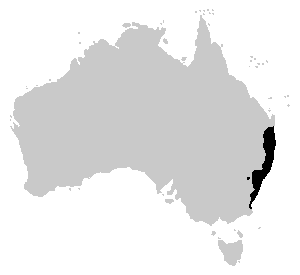
The robust bleating tree frog, also known as Keferstein's tree frog, is a species of tree frog in the subfamily Pelodryadinae. This frog is endemic to coastal eastern Australia, where it ranges from northeastern New South Wales to the NSW/Queensland border. It has also been introduced to Lord Howe Island.
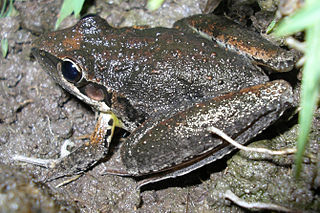
The broad-palmed frog is a species of ground-dwelling tree frog. It is native to much of eastern Australia. They can be found from mid-Queensland to south of Sydney. It is associated with the coast and inland, and is distributed as far west in New South Wales to the South Australia border.
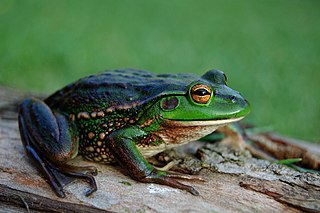
The growling grass frog, also commonly known as the southern bell frog, warty swamp frog and erroneously as the green frog, is a species of ground-dwelling tree frog native to southeastern Australia, ranging from southern South Australia along the Murray River though Victoria to New South Wales, with populations through Tasmania. This species' common names vary between states; the name southern bell frog applies in New South Wales and South Australia, growling grass frog in Victoria, and green and gold frog in Tasmania. This species has been introduced to New Zealand.

The Jervis Bay tree frog, also known as the curry frog in reference to its odour, is a species of Australian frog associated with wallum swampland along the east coast of New South Wales; ranging from the Queensland border to eastern Victoria.

The Blue Mountains tree frog also called the variegated river tree frog is a species of tree frog in the subfamily Pelodryadinae. It is endemic to southeastern Australia and is found in eastern Victoria and in southeastern New South Wales. The Jenolan Caves tree frog, a population formerly separated as Litoria jenolanensis, is nowadays included in this species.
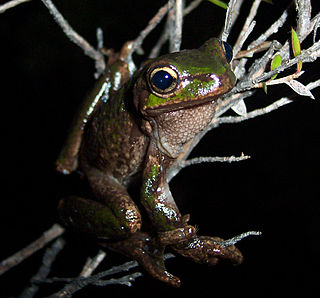
The Tasmanian tree frog, also known as king tree frog, is a species of tree frog that is found on the west coast of Tasmania, Australia. It was first found by Myrtle Burrows in 1941, at Cradle Mountain and handed over to Scott Oswald, who is attributed with the discovery.
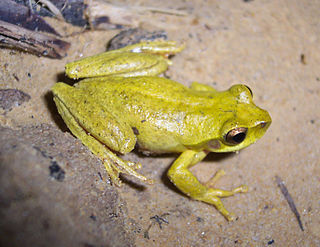
The revealed frog, whirring tree frog, or orange-thighed treefrog is a species of tree frog native to coastal eastern Australia.

The southern brown tree frog, also known as the brown tree frog, whistling tree frog, or Ewing's tree frog, is a species of tree frog native to Australia: most of southern Victoria, eastern South Australia, southern New South Wales from about Ulladulla—although this species is reported to occur further north—and throughout Tasmania including the Bass Strait Islands, in which state it is the most frequently encountered frog. It has been introduced to New Zealand, where it can be locally abundant.

The dainty green tree frog, also known as the graceful tree frog, is a species of tree frog in the subfamily Pelodryadinae. It is native to eastern Queensland, and north-eastern New South Wales, Australia and ranges from northern Cape York in Queensland to Gosford in New South Wales, with a small and most likely introduced population in Hornsby Heights in Sydney. It is one of two faunal emblems of the City of Brisbane.
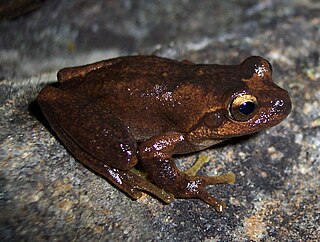
Littlejohn's tree frog, also called a heath frog or orange-bellied tree frog, is a species of tree frog native to eastern Australia from Wyong, New South Wales, to Buchan, Victoria.
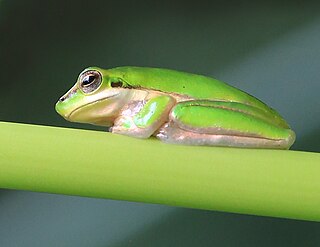
The northern dwarf tree frog is a small species of tree frog native to northern Australia, from the Kimberly region of Western Australia to Bowen, Queensland, and Aru Islands of Indonesia.

The orange-thighed frog is a species of tree frog native to a small area of tropical northern Queensland, Australia. It is a green frog with distinctly orange eyes, and is very similar in appearance to the red-eyed tree frog.
"Litoria" castanea, also known as the yellow-spotted tree frog, New England swamp frog, tablelands bell frog, or yellow-spotted bell frog, is a species of frog in the subfamily Pelodryadinae. It is a critically endangered species of frog that is endemic to south-eastern Australia.
The Strike-a-Light River, a perennial stream that is part of the Murrumbidgee catchment within the Murray–Darling basin, is located in the Snowy Monaro Regional Council area of New South Wales, Australia.




















